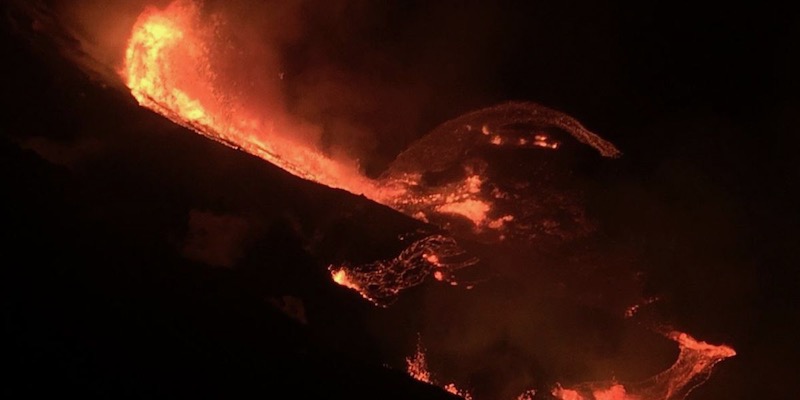
Kilauea – in Hawai’i Volcanoes National Park – is the most active of the five volcanoes that form the Hawaiian islands. Its most recent eruption began December 20, 2020, around 9:30 p.m. local time (7:30 UTC on Monday). The eruption sent lava fountains shooting nearly 165 feet (50 meters) into the sky from a fissure on the eastern side of the volcano. Flowing lava replaced the water that was in the basin of Halemaumau Crater – a pit crater within the much-larger Kilauea Caldera – and a new lava lake was formed.
The 2021 lunar calendars are here! Order yours before they’re gone. Makes a great gift!
Around 10:30 p.m. on Sunday, the scientists logged an earthquake measuring 4.4 magnitude. By 11 p.m., the Hawaiian Volcano Observatory raised the threat level to Warning and switched the aviation color code to Red (advising aircraft to stay away due to a possible ash cloud). Just after midnight, Big Island Civil Defense confirmed no evacuations were needed; the volcanic activity was contained to Halemaumau Crater only. Around the same time, the eruption began diminishing. The ash advisory for aircraft expired around 2 a.m., when scientists announced that the plume from the eruption appeared to be mostly steam, and not filled with other ash and debris. By 6:30 a.m. on Monday, December 21, it appeared the eruption within the crater had stabilized. Lava lake remains. The threat of ash falling continued to diminish. At this writing, two of three fissures remain active.
Here’s the history of the eruption as traced by @USGSVolcanoes on Twitter. For future updates beyond this Twitter feed, try this page at USGS.
HVO Kilauea RED/WARNING – Shortly after 9:30 p.m. HST an eruption commenced within Kilauea’s summit caldera. https://t.co/JrIaEgXyAa
— USGS Volcanoes? (@USGSVolcanoes) December 21, 2020
Red spots are the approximate locations of vents feeding lava flowing into the bottom of Halema‘uma‘u crater. The water lake has been replaced with a growing lava lake. The easternmost vent is currently exhibiting fountains up to approximately 50 m (164 ft) high. pic.twitter.com/KGQfKfwCQx
— USGS Volcanoes? (@USGSVolcanoes) December 21, 2020
Lava is cascaded into the summit water lake, boiling off the water and forming a new lava lake. The northern fissure, pictured, was producing the tallest lava fountain at roughly 50 m (165 ft), and all lava was contained within Halema?uma?u crater in Kilauea caldera. pic.twitter.com/4uEEL7qxOT
— USGS Volcanoes? (@USGSVolcanoes) December 21, 2020
Video of the eruption from Jaggar Overlook at about 11:30 PM HST. pic.twitter.com/7CgZJMNn1R
— USGS Volcanoes? (@USGSVolcanoes) December 21, 2020
Video from W rim of the caldera just before midnight. As of December 21 at 1:30 a.m. HST, the growing lava lake has almost reached the level of the lowest down-dropped block that formed during the 2018 collapse events. Over the past 2 hours, the lake has risen by ~10 m (32 ft). pic.twitter.com/Qbx1d6hbq4
— USGS Volcanoes? (@USGSVolcanoes) December 21, 2020
No major changes as of 4:09 a.m. HST. The fountain on the N wall of Halema?uma?u crater is dominant, with weaker fountaining exhibited at W fissures. The lava lake is slowly rising. A billowing gas plume continues to drift to the southwest. pic.twitter.com/enYj1U9yos
— USGS Volcanoes? (@USGSVolcanoes) December 21, 2020
December 21, 2020 – sunrise at the new eruption site in Kilauea caldera. pic.twitter.com/8TCPsS37Ci
— USGS Volcanoes? (@USGSVolcanoes) December 21, 2020
Early morning photo of the plume generated during the ongoing eruption at #Kilauea's summit. Plume (primarily water vapor, CO2, SO2, with trace amounts of other gases) drifts with the wind (currently toward the SW). Air quality tracker at https://t.co/DQqmT7o7xv pic.twitter.com/shaLKQn79o
— USGS Volcanoes? (@USGSVolcanoes) December 21, 2020
Watch live now at https://t.co/6Dhw1Dii9O https://t.co/RFzyqrN1GU
— @DCHomos (@DCHomos) December 21, 2020
Bottom line: Kilauea volcano’s most recent eruption began on December 20, 2020, around 9:30 p.m. local time (07:30 UTC on December 21). The eruption sent lava fountains shooting nearly 165 feet (50 meters) into the sky and created a new lava lake. By Monday in Hawaii, the eruption was diminishing and appeared stabilized. The lava lake remained.











